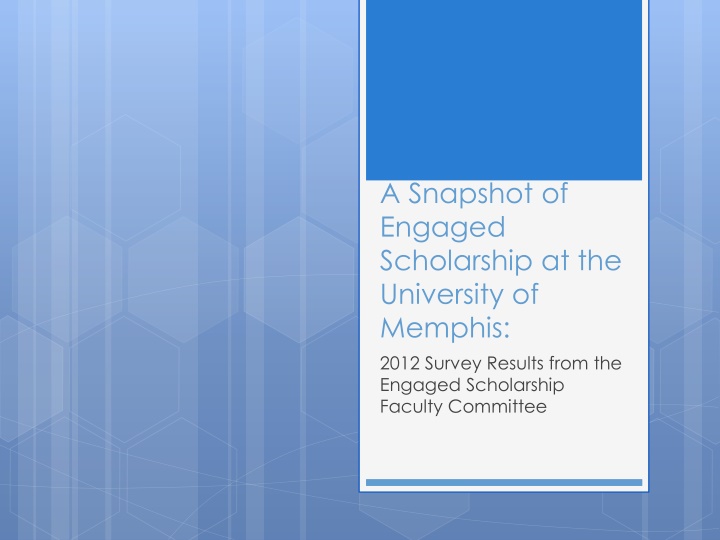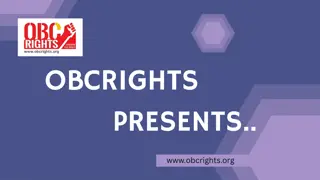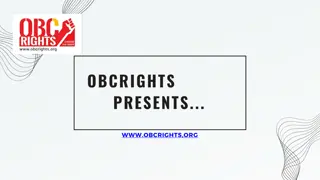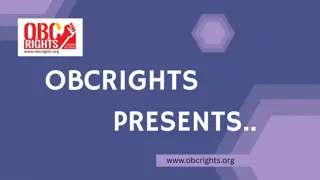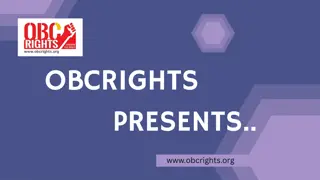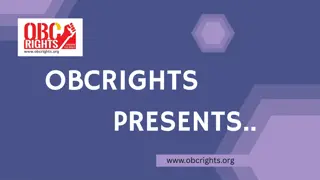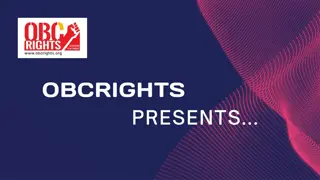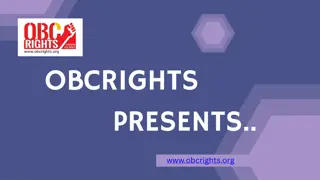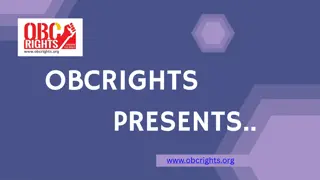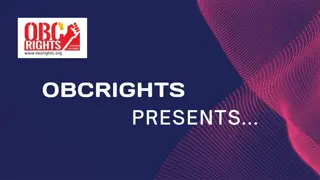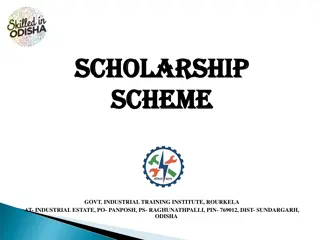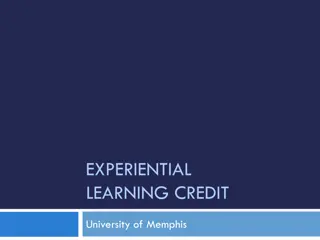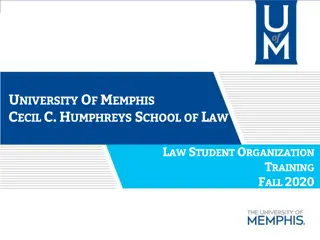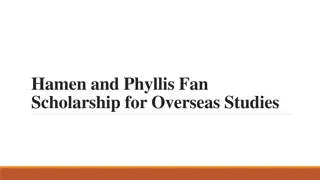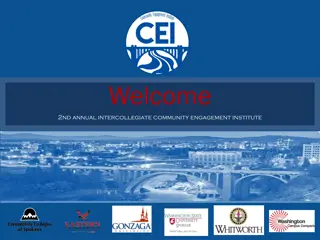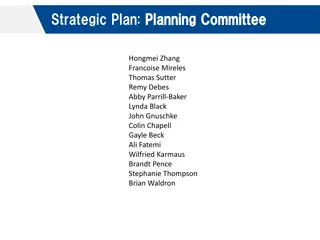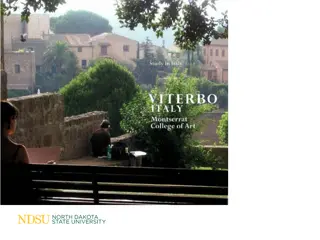Engaged Scholarship at University of Memphis: 2012 Survey Results
The study presents findings from a survey conducted at the University of Memphis to assess faculty members' community involvement, providing insights into demographics, academic ranks, and colleges represented in the sample. The report aims to inform recommendations for advancing Engaged Scholarship at the institution.
Download Presentation

Please find below an Image/Link to download the presentation.
The content on the website is provided AS IS for your information and personal use only. It may not be sold, licensed, or shared on other websites without obtaining consent from the author.If you encounter any issues during the download, it is possible that the publisher has removed the file from their server.
You are allowed to download the files provided on this website for personal or commercial use, subject to the condition that they are used lawfully. All files are the property of their respective owners.
The content on the website is provided AS IS for your information and personal use only. It may not be sold, licensed, or shared on other websites without obtaining consent from the author.
E N D
Presentation Transcript
A Snapshot of Engaged Scholarship at the University of Memphis: 2012 Survey Results from the Engaged Scholarship Faculty Committee
Study Goals 1. To learn more about the scope and reach of community involvement by faculty members at the University of Memphis. 2. To generate short and long term recommendations for advancing Engaged Scholarship at the University of Memphis.
Survey Administration and Sample Size A Qualtrics survey, designed by the Engaged Scholarship Faculty Committee, was sent by the Provost s office to all U of M faculty. 390 individuals responded; 248 surveys were completed in full. This presentation reports data from the 248 completed surveys.
Sample Demographics: Gender 2% Female Male Other 44% 54%
Sample Demographics: Ethnicity 1%5% 6% 9% White Black, not Hispanic 79% Hispanic Did not identify
Years of Employment 23% 10+ 44% 7 to 10 3 to 6 21% Under 3 13%
Academic Rank 8% 26% 10% Professor Assistant Professor 16% Associate Professor Instructor 23% Adjunct 18% Other 18% of respondents held administrative positions
Colleges & Schools Represented in Sample 42% 18% 14% 11% 4% 3% 2% 2% 2% 1% 1% College of Arts and Sciences College of Communications and Fine Arts College of Education, Health, and Human Sciences Fogelman College of Business and Economics Herff College of Engineering Lowenberg School of Nursing University Libraries School of Communication Sciences and Disorders University College Cecil C. Humphreys School of Law School of Public Health
Tenure Status of Respondents Not on Tenure-track 42% Tenured 40% On Tenure-track/untenured 18%
The Nature of Community Involvement
My Community Involvement Involves: Community-university partnership that led to peer-reviewed publications, impact, or external funding 37% Shared ownership of research process with community members 26% Capacity-building among community members 64% 43% Applied research 44% Community-based research 71% Reciprocal relationship between UofM and broader community 57% Volunteerism 67% Outreach
What Issues Do You Work On In Your Community-Based Research? Aging 6% Architecture and Design 6% Art 9% Children and Youth 3% City Planning 10% Cultural Heritage 16% Economic Development 15% Education 45% Empowerment 17% Environment and Conservation 15% Faith-based 14% Health and Well-being 31% Housing 10% Labor 5% Legal 5% Minority Issues 23% Neighborhood Development 16% Parks and Recreation 13% Poverty 14% Public Policy 9% Public Safety 9% Transportation 7% Other 19%
Respondent Examples of Community Involvement Demonstrating U of M Faculty Collaboration, Applied Research, Capacity-Building, External Funding, Reciprocity, and Shared Ownership of Results
Example of Community Involvement I have worked on the Living Wage Campaign, drafted a non-discrimination ordinance for County and City employees, and drafted an Anti-bullying bill for the TNGA.
Example of Community Involvement As part of NIH grant (2004-2011) and a grant from the TBR Diversity Office, we worked with Memphis City Schools in neighborhoods with large Hispanic populations. We conducted longitudinal research in elementary schools. Currently, as part of a US Dept. of Education grant, we have developed a clinic with onsite Spanish-English interpreters to better serve the Hispanic community. As part of this grant, we have reached out to area clinics, physicians, churches, and Latino Memphis, to make the community aware of the services we are now able to provide. The response has been very positive
Example of Community Involvement Held, along with students of architecture at the U of M, design charettes with members of communities to allow citizens the opportunity to make suggestions, offer solutions, and generate buy-in in the design of their community. Furthermore, work with other civic groups to determine the best ways to plug citizen groups into the fulfillment of the community masterplan.
Examples of Community Partners AmeriCorps ArtsMemphis Baptist Hospice BRIDGES USA Central Arkansas Water City of West Memphis Friends of T.O. Fuller Germantown Performing Arts Centre Youth Symphony Orchestra Livable Memphis Make a Splash Mid-South Swimming Program The Med Memphis Advisory Council for the Hearing Impaired Memphis Area Legal Services Memphis Arts Festival Memphis Grizzlies Memphis Police Department Blue C.R.U.S.H Methodist Hospitals Mid-South Reads Pink Palace Shelby County Government Shelby Farms Park Conservancy St. Jude Research Hospital Memphis City Schools TN Parks and Greenways Tipton County Schools Urban Land Institute U.S. Attorney s Project Safe Neighborhoods Westwood Neighborhood Association Workers Interfaith Network Youth Villages
Developing Civically Engaged Students
Providing Service-Learning Opportunities for Students 49% of faculty incorporate, or have incorporated, service-learning within their classes. 84% of instructors who include service- learning do so at least once a year.
Mentoring Students in Community-Based Work 49% of faculty have mentored students in completion of community-based internships or practica. Undergraduate and graduate students are pursuing these experiences at a similar rate.
Example of Service-Learning I took my students to their neighborhood clean ups to do service and related it to urban sociology and Broken Windows theory.
Example of Collaborative Research [I] involved students in [an] urban policy course in [the] analysis of policy issues in housing, homelessness, [and] health access in partnership with neighborhood associations and nonprofit agencies.
Examples of Mentoring ...All funded students must plan and conduct some sort of community outreach that involves issues pertaining to cultural and linguistic diversity. Students teach art in community settings as part of course requirements. We meet as a team with community representatives and plan appropriately.
Respondent Views on the University s Commitment to Engaged Scholarship
Engaged Scholarship at U of M: Involves academic projects that engage faculty members and students in a collaborative and sustained manner with community groups. Connects university outreach endeavors with community organizational goals. Furthers reciprocal relationships between the University and the community. Entails shared authority in the research process from design to implementation. Results in excellence through such products as peer-reviewed publications, peer-reviewed collaborative reports, documentation of impact, and external funding. 57% of respondents currently participate in engaged scholarship, or have in the past Another 30% would like to do so in the future
Facultys first exposure to the principles of Engaged Scholarship? 36% at the University of Memphis 20% as a graduate student at another institution 12% as an undergraduate student at another institution
Does the U of M indicate a commitment to community engagement as a priority in its mission statement or vision? 60% Responded YES
Does the U of M Administration Value and Reward Engaged Scholarship? 35% said YES 24% said to Some Extent
Does the U of M formally recognize community engagement through awards and celebrations? 28% 40% Yes No Don't know To some extent 18% 23%
Does the U of M have mechanisms in place to assess community perceptions of U of M community engagement? 7% 11% 19% Yes No Don't Know To some extent 63%
Does the U of M have a campus-wide coordinating infrastructure to support and advance engaged scholarship? 11% 16% 15% Yes No Don't know To some extent 58%
Assessment of Engaged Scholarship at U of M Most faculty know that engaged scholarship is part of the university mission (60%) Many faculty are either conducting (57%) or would like to conduct engaged scholarship(additional 30%)
Further Assessment of Engaged Scholarship at U of M The majority of respondents are involved in community partnerships (65-68%). However, fewer meet all the criteria of the U of M definition of engaged scholarship, especially with respect to shared authority and the production of peer-reviewed publications, policy change, or external funding.
Perceptions of U of M Support for Engaged Scholarship Most faculty do not feel engaged scholarship is widely rewarded on campus (only 35% feel that it is). Most faculty do not believe engaged scholarship is supported through on-campus infrastructure (only 11% report infrastructure exists). Most faculty do not believe engaged scholarship is assessed for its value in the wider community (only 11% believe assessment procedures are in place).
Recommendations Top Priorities of Survey Respondents
Respondent Priorities Establishing a campus-wide Center for Community Engagement was a top priority for Survey respondents (57%). Other Respondent Recommendations: Highlight ES in recruitment and fundraising materials Provide ES mentors for less experienced faculty Provide a variety of financial incentives Make ES a priority in faculty hiring Develop an institutional strategy for tracking for ES
Recommendations by Engaged Scholarship Faculty Committee Short Term (9-12 months)
Centralization/Coordination Shore up infrastructure and build future capacity through Provost-level support for: Recurring funds to support faculty component of Strengthening Communities Initiative Graduate Assistantship dedicated to ESFC Campus visits by nationally-recognized ES leaders to share best practices to enhance ES at the U of M
Faculty Development Increase awareness of engaged scholarship: Develop a brief for ES website as a reference for faculty and community partners Undertake meetings with departments and/or small groups of faculty to advance understanding of engaged scholarship
Institutional Tracking Establish baseline understanding of faculty and student involvement in ES: Identify institutional resources where data can be tracked to generate annualized reports of service learning and engaged scholarship
Recommendations by Engaged Scholarship Faculty Committee Mid-Term (within 24 months)
Centralization/Coordination Establish an Office/Center for Community Engagement
Faculty Development Grow number of faculty conducting engaged scholarship: Develop ES faculty mentoring program Provide small financial incentives for faculty doing service learning related to ES
Institutional Tracking Institutionalize tracking mechanisms for student and faculty doing service learning and/or ES Designation of service learning courses in course catalogue
Recommendations by Engaged Scholarship Faculty Committee Long Term (2-5 years)
Centralization/Coordination Ensure Office/Center is staffed and funded in a sustainable and integrated way
Faculty Development Broaden involvement of faculty across all Colleges and Schools
Institutional Tracking Formalize and standardize tracking of ES across all Colleges and Schools
ESFC Survey Team Keri Brondo Katherine Lambert-Pennington Linda Bennett Michael Hagge Robert Connolly Questions? Contact: kbrondo@memphis.edu or almbrtpn@memphis.edu
